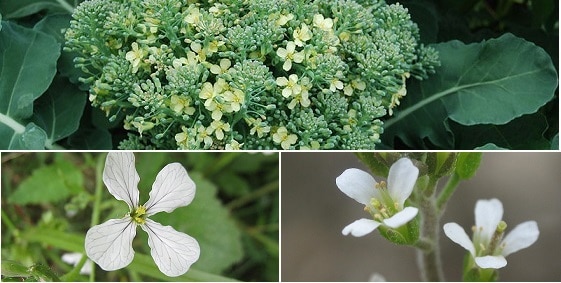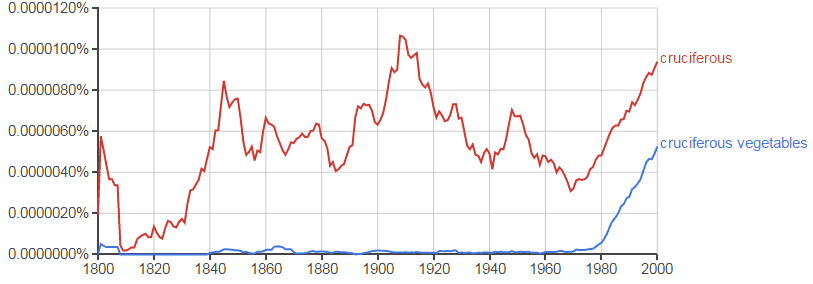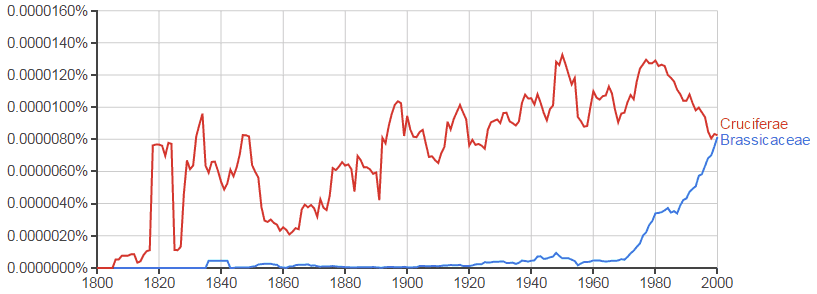To modern ears, “cruciferous” is all about vegetables. But the word’s rich history shows that it was formerly used in a much broader sense.
By Eric Rumsey, Janna Lawrence and Xiaomei Gu
In a Google search for the word “cruciferous,“ 9 out of the top 10 retrievals contain the phrase “cruciferous vegetables.” This certainly does fit the predominant modern usage of the word. As a game show host might say, “what do you think of when I say ‘cruciferous’?” Well, of course, “vegetables”! But it hasn’t always been this way. As the Google Ngram chart below shows, the phrase “cruciferous vegetables” only came into prominent use about 1980. Before that, the word “cruciferous” was widely used in other contexts.
To understand the real meaning of the word, it’s important to understand what these other contexts are. This is important for more than simply historic reasons; it’s also important to understand the meaning of the word to understand its connections to nutrition, and because it helps to search for the subject in databases such as PubMed (as we’ve discussed in a companion article). Additionally, it’s a surprisingly interesting story.
The key to understanding “cruciferous” is a knowledge of its rich botanical history. The chart below gives a hint of this. The chart is a comparison of the use of the words Cruciferae and Brassicaceae. These are names that have been assigned to the plant family that contains “cruciferous vegetables” and many other plants as well. As the chart indicates, Cruciferae was the name of the family until the early 20th century, when it was officially changed to Brassicaceae. Since then, botanists have gradually been switching the word they use, with continuing widespread use of the older name Cruciferae.
This seemingly arcane naming distinction is important because when the family name was Cruciferae, the word cruciferous was used to include all plants in the family, not just the edible species that we call “cruciferous vegetables,” which helps explain the common use of the word in the chart above. (Examples from Google Books of the broad botanical use of the word “cruciferous” in the 19th century are here, here, and here.) The significance of this is magnified by the fact that the family is very large, containing 372 genera and 4060 species, making it one of the largest flowering plant families. This and other details of the family are well-covered by a Wikipedia article on it. Another detail that gives an idea of the size and variety of the family and helps explain the widespread use of “cruciferous” is that, in addition to cruciferous vegetables, it also includes decorative flowers, weeds, and Arabidopsis thaliana (“a very important model organism in the study of the flowering plants”).
Relating to the image of three flowers at the top of the article, another help in understanding “cruciferous” is the etymology of the word itself. The word comes from the word “cross,” because the 4-petaled flowers have the appearance of a cross. The flowers in the image above are (from left) Raphanus sativus (Wild radish weed), Brassica oleracea (Broccoli) and Arabidopsis thaliana. (Images are from Wikipedia).
In conclusion, the word “cruciferous” is confusing because the word has its origins in a time when the large family Brassicaceae was called Cruciferae, which meant that all of the plants in the family (most of which are not edible) were referred to as “cruciferous.” In the last generation, as botanists have switched to calling the family Brassicaceae instead of Crucuferae, and as people have become more aware of nutrition, the word “cruciferous” has gradually come to be used most commonly in the context of “cruciferous vegetables.” As we’ll discuss in a companion article, it’s important to know about this history and the taxonomic relationships of cruciferous vegetables in order to do successful searches in research databases like PubMed.



